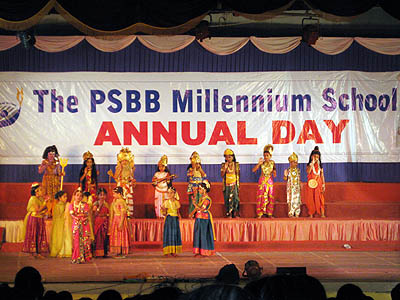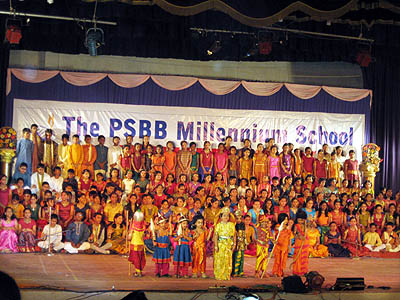The 4th Annual day of the P.S.B.B Millennium School took place on the July 4, 2009, at the Kamaraj Memorial hall.
The theme for the show was ‘Navarasamayee Janaki’. The Navarasas are the nine expressions that are most commonly found in a person’s life. The Navarasas are – Abdhutham, Shringaram, Veeram, Haasyam, Karunyam, Bheebatsam, Roudram, Bhayanakam and Shantham.
 The program was initiated by an invocation to lord Ganesha, in the form of a Bharathanatyam dance. The dance was performed by the girls of classes 7, 8, 9 and 10. The formations by the dancers, highlighted by the lighting effects, made the prayer dance a grandeur.
The program was initiated by an invocation to lord Ganesha, in the form of a Bharathanatyam dance. The dance was performed by the girls of classes 7, 8, 9 and 10. The formations by the dancers, highlighted by the lighting effects, made the prayer dance a grandeur.
The dance was succeeded by mesmerizing songs sung by the school choir. The songs were sung in 9 different ragas, giving an in-look about the whole show. The school choir consisted of about 200 children, whose voices combined gave a feast to the audiences’ ears.
The first Rasa – Abdhutham, which means wonder, was presented by the 3 week old OMR branch of the school.
Sita’s birth and childhood were in itself wonders. This Rasa was presented in the form of a play. The drama begins from the time king Janaka, longing for a child, performs a yagnya. That is when a baby girl was found. She was named Sita. One day when she was playing at her palace with a ball, the ball rolls and gets stuck under the Shiva Dhanush. The Shiva Dhanush was a bow that couldn’t be lifted by even elephants. When Sita lifts it and retrieves her ball, everyone including king Janaka is surprised.
The Rasa Shringaram pictured the marriage of Sita with Rama. The drama started with people from the village decorating and celebrating the swayamvara. The prince who could lift and break the Shiva Dhanush would be the person to marry Sita. Many kings and princes try the challenge, but the bow would budge. Rama at last casually lifts the Shiva Dhanush and breaks it. Rama and Sita are married. The drama was presented by student of classes 1 – 3. There was a loud round of applause for these young kids at the end of this show.
The next drama displayed Veeram or bravery of Sita.
 Kaikeyi who had been granted two boons from king Dasaratha, asked for Rama to go to the forest in exile for 14 years. Rama decides to leave to the forest. Sita, who had been brought up in all the comforts of a palace, shows bravery by accompanying Rama to the forest.
Kaikeyi who had been granted two boons from king Dasaratha, asked for Rama to go to the forest in exile for 14 years. Rama decides to leave to the forest. Sita, who had been brought up in all the comforts of a palace, shows bravery by accompanying Rama to the forest.
The fourth Rasa for the evening was Haasyam or laughter. It showed the lighter moments shared by Rama and Sita in the forest.
Sita was well known for Karunyam – kindness. The drama showed an episode in which Sita shows kindness towards Kakasura who had been disturbing Rama and Sita by continuously pecking.
Bheebatsam which means disgust is portrayed in this drama. The participants display the scene in which Surpanaka, after Rama’s refusal asks Laxmana to marry her. Sita shows her disgust towards Surpanaka.
The story of Ramayana took a huge turning when it reached the familiar golden deer episode. Sita asks for the radiant deer. Rama decides to get it for her and asks Laxmana never to leave her side. The deer mimics Rama’s voice and sends pleas for help. Laxmana bound by his word to his brother doesn’t leave. Sita shows Roudram or anger in this play.
Bhayam is expression shown in the next drama. Sita is held in captive by Ravana. Sita gets scared when Rama doesn’t arrive. At that time Hanuman makes a miraculous entry and Sita feels relieved.
The last but definitely not the least expression is Aanandham – happiness. Sita and Rama return to Ayodhya after 14 years of exile. Rama is rightfully coronated as the king of Ayodhya. This formed the grand finale of the whole program bringing smiles to one and all!
After all the plays, dances and songs, the chief guest, Chitra Visweswaran, well-known Bharatanatyam dancer spoke a few words on the celebrations. She pointed out the fact that when children actively participate in such programs, both their right and left brain develops. This makes them think logical and at the same time be creative and imaginative.
The students had really learnt a lot during the previous week of practice. It made the students and the teachers more aware of the universal Ramayana. It would have definitely sunk into their minds as they had enacted out some highlights of the story, because when one gets involved into something, they master it.
The students’ and the teachers’ efforts along with the one-of-a-kind theme made the whole show a memorable one.
